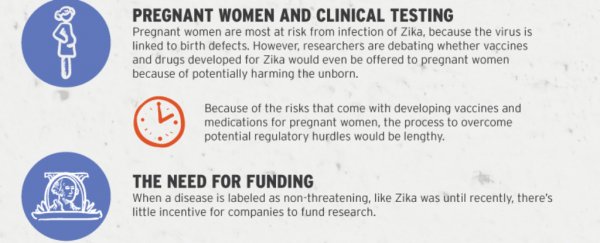Zika virus has been rampantly spreading throughout the tropics over the past six months, with mosquitoes now transmitting the disease in more than 42 countries, and thousands of people becoming infected - including pregnant women.
To make the situation worse, last week, scientists announced that Zika was officially linked to birth defects, including microcephaly. And we also know that it can be sexually transmitted, making the need for a vaccine against the disease more desperate than ever before.
But if this infographic created by Dickson Data is anything to go on, we're still in for a long wait - which means it's more important than ever before to avoid exposure to the virus.
Scientists around the world have already started the process, with an Indian biotech company saying they have two candidate vaccines ready for pre- clinical trials, and the US National Institute of Allergy and Infectious Diseases (NIAID) claiming it will start testing its own vaccine by September.
So what makes it so hard to get these vaccines on the market? First of all, there's a whole lot of testing that needs to happen between lab tests and clinical trials.
Both the NIAID and Indian team are getting ready to test their vaccine candidates either in lab models or in animals - but it can take years before those trials produce results that are promising enough to move into human trials.
And once clinical trials start, there's no guarantee that the produce will actually be safe and efficient enough to make it onto the market. Then there's the small issue of funding and distribution.
Check out the infographic below (or the high-res version here) to find out the challenges ahead, and feel very appreciative of the scientists working round-the-clock right now to get us a Zika vaccine. We salute you.

